Kern F 7x45
| Dieses 7x45 Monokular von Kern Aarau ähnelt in seiner Bauweise dem Zeiss Noctarmo 7x50 und hat ebenfalls ein Abbé-König Prismensystem. Ein baugleiches 7x50 Modell gibt es auch. Da das Glas zum einem mit einer Strichplatte, mit einer Strichplattenbeleuchtung ausgestattet ist und in einem olivgrünen Metallbehälter transportiert werden kann, zum anderen die Optik unvergütet ist, ist es nicht nur als Militärfernrohr identifizierbar, sondern auch vor oder während des 2. Weltkrieges hergestellt worden. Der vierfach verschraubte schwarz lackierte Deckel ist mit "Kern Aarau F. 7x45 No 14025" beschriftet. Am Tubus sind zwei blanke Aluminiumstellen zu sehen, wo das Monokular auf die die Tragevorrichtung auf eine Kugellafette geklemmt wurde; so diente das Monokular als Ziel- und Beobachtungsfernrohr der Festungsartillerie (s. Foto: Fernrohr an einer Kugellafette als Schartenfernrohr). Eine andere Montageeinrichtung weist ein Kimme und Korn-Visier auf (s. Foto: h.w.) und ist Teil des Kommandogerätes zum Entfernungsmesser für die 34mm Flab Kanone der Schweiz (s. Fotos 4-5). | This 7x45 monocular by Kern Aarau resembles the Zeiss Noctarmo 7x50 and also has an Abbé-König prism system. There also is a 7x50 model of same the design. As the glass has a built-in graticule, a graticule lighting and comes with an olive green box, furhtermore as its optics are uncoated , it can identified not only as a military device but also be dated as being made before or during WWII. The cover plate has four screws, is painted black, and is marked "Kern Aarau F. 7x45 No 14025". There are two blank rings on the monocular. This is where the monocualr was clamped onto a mounting rack fixed to a ball carriage. Thus the 7x45 was used as an aiming and observing telescope by the fortification artillery (see photo: monocular moutned on a ball carriage as a embrasure telescope). Another mounting comes with a analogue sight (cf. pic. by h.w.) and is part of the director apparatus for a rangefinder of the Swiss 34mm Flab gun (AA rangefinder) (see pics 4-5). |

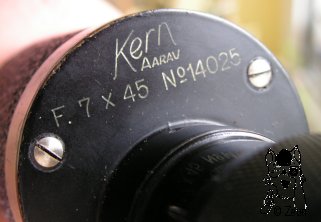
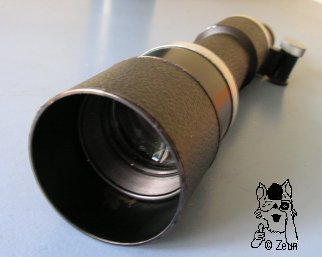
| Das Monokular hat ein Aluminiumgussgehäuse mit Kunstlederummantelungen. Das Prismengehäuse ist 51mm im Durchmesser und 66mm hoch. Das 50-64mm lange Okularstück hat eine 34mm Kunststoffaugenmuschel, hat einen Durchmessr von 33mm beim geriffelten Fokussierungsring (mit Dioptrienskala: +/-5), von 28,5mm an dem Okulartubus und 31mm beim Ansatz bzw. Strichplattenteil. Der konische Objektivtubus ist 78mm lang und verbreitert sich von 41 auf 50mm. Der gerade Endtubus mit Objektivlinse misst 62mm im Durchmesser bei einer Länge von 66mm. Dort folgt nach einem blanken Aluminiumstück (8mm) ein schwarz lackierter Endteil, auf dem eine Kunstleder ummantelte und ausziehbare 45mm lange Sonnenblende sitzt. Die Objektivlinse liegt 1,5cm zurück versetzt im Endtubus, bzw. 4,5cm bei ausgezogenem Blendschutz. Die Gesamtlänge liegt somit zwischen 25 und 26,5cm (plus 3cm für die Sonnenblende). Das Glas wiegt 755g. | The monocular has an aluminium housing with some synthetic leather covering. The prism box is 51mm in diameter and 66mm tall. The 50 to 64mm long ocualr piece has 34mm eyecup made of plastic . The knurled focusing ring measires 33mm, having a dioptre scale ranging from + to - 5. The ocular tube itself is 28.5mm in diameter. The ocular part with the lighting unit mount and graticule inside is 31mm. The conical objective tube is 78mm in length, increasing from a 41 to 50mm diameter. The straight objective tube with its objective lens measures 62mm in diameter and 66mm in length. There, following a blank metal ring (8mm), is a böacl painted end part which holds a 45mm long and syntehtic leather covered ray-shade that can be extended. The objective lens is recessed by 1.5cm or 4.5cm when the ray-shade is extended. Overall length is 25 to 26.5cm (plus 3cm of the ray-shade). The glass weighs 755g. |

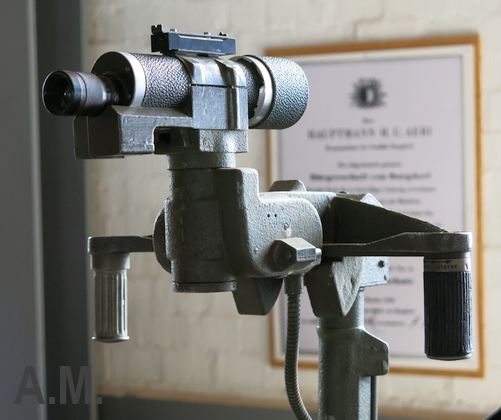
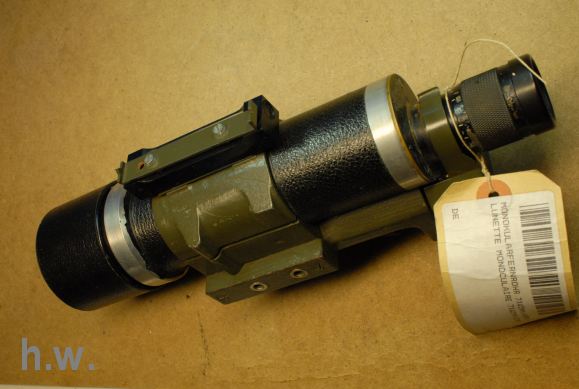
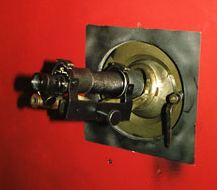
| Der Transportbehälter mit der Gerätenummer 248 ist 29cm x 17cmm x 8cm und wiegt mit Zubehör ca. 2490g. An einer Kopfseite hat er einen klappbaren Tragebügel und an der Längsseite zwei Verschlussbügel sowie eine Schliesslasche, so dass sich mit einem kleinen Schloss der Behälter abchliessen lässt. Am Boden und Deckel des Behälters befinden sich mit Filz gedämpfte Ablagehalterungen für das Monokular. In der Mitte sind auf einem Metallstreifen jeweils eine Halterung für die zwei Filter (grün, gelb) und die Beleuchtungseinheit (Fassung und Birne) befestigt. Weiterhin befindet sich im Kasten ein Stromzufuhrkabel mit einem Sockel für die Beleuchtungseinheit und Batterieklemmen für die benötigte 12V Batterie. | The carrying box with number 248 measures 29 x 17 x 8 cm and weighs ca. 2490g with accessories. There is a foldable holder at the shorter side, and two latches as well as a catch at the longer side. The catch can be secured with a small lock. Felt lined supports for the monocular are attached to the lid and bottom of the metal box. There is also a metal strip screwed to the bottom holding mounts for the two filter glasses (green and yellow) and for the lighting unit with its fitting and bulb. A power cable is also supplied, having a socket for the lighting unit and clamps for a 12V battery at each end. |
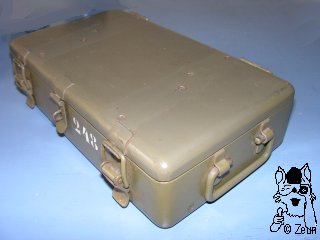
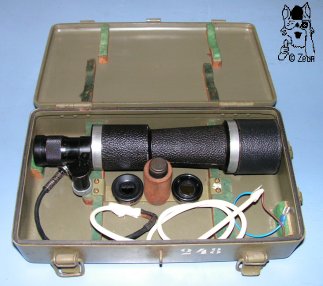
| Die angeschlossene Beleuchtungseinheit wird in eine am Okular angebrachte Hülse gesteckt und dient zur Beleuchtung der Strichplatte. Diese weist eine horizontale Stricheinteilung in 5er Schritten von 40 links bis 40 rechts auf. Die senkrechte Stricheinteilung geht ebenfalls in 5er Schritten nach oben bis 40 und unten bis 10. Bezeichnet sind jeweils "20" und "40". | The connected lighting unit goes into a mounting tube attached to the eyepiece. It is, of course, used to lighten the graticule. The latter has a horizontal division ranging from 40 to the left to 40 to the right, each line marking 5 steps. so does the vertical division ranging from 10 below and 40 above the horizontal scale. Only '20' and '40' appear as numbers on the scale. |

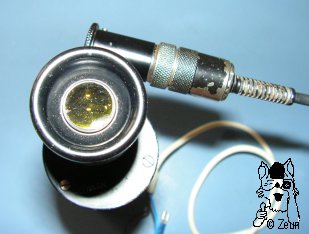
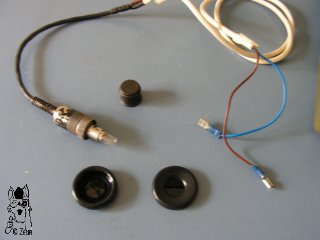
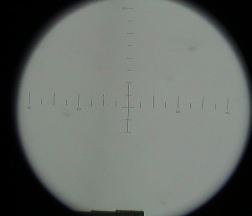
Fotos: Zeun; 4 aus "Hasler 1852-1952, Hundert Jahre Hasler"; 5 (Monokular Halterung auf dem Kommandogerät zum Entfernungsmesser zur 34mm Flab Kanonne (1938) im "Schweizerisches Militärmuseum Full") A. Masson; 6 H. Weigum; 7 Internet (exact source website forgotten)

